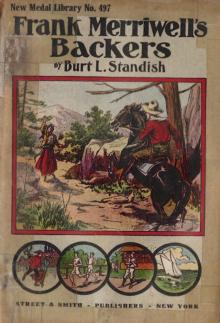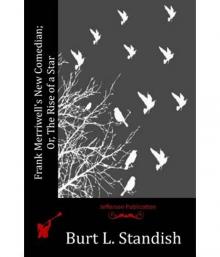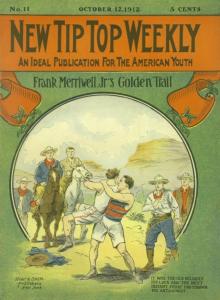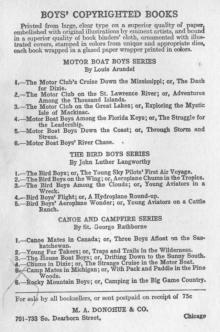- Home
- Burt L. Standish
The Swan and Her Crew Page 28
The Swan and Her Crew Read online
Page 28
CHAPTER XXVI.
The Life of a Fern.[1]
[1] For this Chapter I am indebted to my friend Mr. William Whitwell, of Oxford.
One of the most marvellous of "the fairy tales of science" has now toengage our attention for a time. The growth and fertilization of theseeds--more properly called spores--of ferns, present phenomena ofremarkable singularity and interest. Growth is advisedly named first, asin the present instance it really does occur before fertilization, whichis not the primary event in the life-history of a fern.
But a few words must be devoted to the preliminary question: What is afern?
The vegetable kingdom is divided into two great provinces, allottedrespectively to the flowering and the flowerless tribes. The floweringplants have several distinct and visible organs for the formation andfertilization of their seed, to each of which is assigned a special andnecessary office. In the flowerless section, on the contrary, there arenone of these visibly separate agencies in reproduction, and what areusually termed the seeds do not show any parts representative of thedeveloped product. In the true seeds, which belong to flowering plantsalone, are contained the rudiments of a stem, leaves, and root, but inthe spores of the flowerless plants nothing of the kind is found. Thespores, again, are microscopic, while the smallest of true seeds can benot only seen but easily picked up. You have, doubtless, met with thepeculiar fungus called a puff-ball, and amused yourselves by watching thelittle clouds of impalpable dust which are shaken from it on theslightest motion. Those fine clouds, not nearly so visible as a film ofcandle smoke, are composed of innumerable spores, and such are therepresentatives of seeds in every member of the great section of theflowerless plants.
Now it is peculiar to ferns, that the cases in which these spores areenclosed grow directly from the veins of what is usually called theleaf, but is more correctly termed the frond, and always appear upon theback or at the margin.
Ferns, then, are flowerless plants which bear their spores in casesgrowing upon the back or margin of the leaves.
In order that the phenomena of growth and fertilization in ferns may beclearly understood, it is necessary to refer to the process as takingplace in flowering plants. The tulip is most appropriate for anillustration, inasmuch as its various parts will be recognised withease.
At the bottom of the blossom is a thick green oval body called theovary, which afterwards becomes the seed-vessel. At the top, thisnarrows into a short column, surmounted by a three-cleft knob. Betweenthe ovary and the gorgeously painted flower-leaves are six curiousorgans, termed stamens, consisting each of a long and rather slenderstalk, and a head formed somewhat like a hammer.
If the green oval ovary in the centre is cut in two, it will be founddivided into three chambers, in one or another of which, not usually inall, will be seen a row of little knobs or buttons attached to thepartition in the middle. These little buttons are ovules, or seed-germs,and the special office of the ovary is to produce these germs, and tocontain them until their full development and complete ripening intoseeds. But if the knobs are left just as they are, unfertilized, theycan never become seeds, and the plant will fail to reproduce its kind.
Turn we now to the stamens. Each of their hammer-like heads has twochambers, full of beautiful little grains which are called the pollen.Each grain is tastefully and delicately marked, and holds a transparentwatery fluid, in which a number of extremely small solid particles arefloating. What is required for the fertilization of the seed-germsis--that this fluid should be conveyed to and taken up by them. But theyare in the centre of the thick green ovary--this in the chambers of thestamens!
A simple arrangement brings all about. At a certain time we may see theblack heads of the stamens covered with a fine flour, which adheres towhatever touches them. This flour is made up solely of pollen-grains,escaping in unimaginable numbers from the chambers where they areproduced. At the same time the knob which crowns the seed-vessel putsforth a thick and gummy ooze. The stamens are just long enough for theirheads to rise a little above this knob, upon which the pollen, whenescaping as I have stated, falls in great quantity, and is there heldfast.
Each grain then begins to swell, and to sprout (as the Rev. J. G. Woodhas it) something like potatoes in a cellar. All the sprouts, however,pierce the knob, and push downwards until they reach the seed-germsunderneath. Each sprout is a tube of extreme minuteness, and when itreaches a germ, attaches itself thereto, and, through the channel soformed, the fluid is drawn out of the pollen-grain and absorbed by theembryo seed. Fertilization is thus effected, and the growth anddevelopment of the germ proceeds until it becomes a seed fully able,when planted, to reproduce a tulip.
FERN SPORES.]
In ferns, the spores ripen and are ready for dispersion and partialgrowth without any process of the kind. But, in truth, fertilization isas necessary to the continuance of ferns as to the perpetuation of otherplants. The main difference lies in this: that the means offertilization, and the real germs of new plants, are produced from thespores after they begin to grow.
When a spore falls upon a proper place for its development, a portionof the outer membrane begins to swell, and a tongue-shaped projection isformed, which becomes a sort of root. The one chamber of the sporegradually subdivides, and becomes two, four, and so on, until for thesimple spore we have a tiny leaf-like expansion, now known as the_prothallium_, or representative of a leaf.
Further than this the spore alone has no power to go, and theprothallium is not truly the germ of the future plant. True germs,needing fertilization, are produced upon it, and also the means wherebythey can be fertilized. These can be distinguished only by use of thehigher microscopic powers. If a portion of the prothallium is examined,it will be found studded with little bladders, containing roundsemi-transparent bodies of a greenish hue.
There may also be seen, though in fewer numbers, pellucid cells of anentirely different character, consisting apparently only of a finemembrane, forming an angular chamber, shaped in some instances like alantern of extreme delicacy and elegance. From the top of this chamber afunnel-like shaft descends to a little germ which is situated at thebottom. This germ is the real original of the future plant, and theround bodies in their little cells, just before described, are the meanswhereby it is to be fertilized and receive energy to develope into theperfect fern.
But how can the needful contact between the germs and the fertilizingbodies be brought about? Observation and experiment supply a strangeanswer to this question.
The round bodies in the tiny bladders acquire a spiral or shell-likeform when they become mature. If a drop of water is then placed incontact with the bladders, their contents will suddenly escape,retaining for a moment the coiled appearance, but quickly lengtheningand partially unrolling.
By means of hairs with which they are furnished, and which at oncecommence a ceaseless jerking motion, they forthwith launch out into thewater, and conduct themselves therein more like creatures endowed withconscious life than mere organs of a settled and sedate member of thevegetable kingdom.
These bodies, drawing near the germ-cells in the course of their travelsthrough the, to them, vast ocean of the water-drop, have been seenarrested in their progress and passing down the funnel-shafts to thegerms below--so fulfilling the purpose for which they were designed andtheir curious swimming powers were given.
The germs, so fertilized, become the underground stems of which I haveyet to speak, putting forth roots and producing the tender, rolled-upbuds which finally expand into the fronds whose grace and beauty we somuch admire.
These germs, appearing on the prothallium or leaf-like expansion of thespore, are the true representatives of seeds, and the swimming bodiescorrespond to the pollen or fertilizing dust of flowers.
Thus we see that germs and means of fertilization are produced in thefern as truly as in higher plants, and that the simple agency wherebythe one may reach and exert the needful action upon the other, is the_dew-drop_ resting on the proth
allium from which they are developed.Without the dew-drop or the rain-drop as a means of communication bothmust perish with their mission unfulfilled. This is, perhaps, one of themost singular instances ever to be found, of the mutual dependency ofcreated things, or, to give different expression to the same idea, ofthe mode in which each link of the great network of existence isconnected with every other.
Returning to the fern, whose "strange eventful history" we have tracedso far,--the germ enlarges and becomes what is usually called the root,but is really an underground stem. The true roots are the littlefibres--often black and wiry, looking more dead than alive--whichdescend from this.
The stem may be of two kinds--long, thin, and creeping, as in the commonpolypody, or short, stout, and upright, as in the common male fern.
At intervals along the creeping stem, or arranged more or less regularlyaround the crown of the erect stem, little buds appear, which eventuallyform the fronds which are the really conspicuous portion of the plant,and whose aspect is familiar to us all. The buds present a character ofgreat interest and singularity. Instead of being simply folded together,as leaves generally are,--in all but two of our British kinds the frondsare rolled up after the fashion of a crosier or shepherd's crook. Individed fronds, the sections are rolled up first, and singly, and thenthe whole are rolled up again, as if forming but a single piece. Theaspect of some of these young fronds--in the common bracken, forinstance--with their many divisions all partially unrolled, is oftenhighly curious.
But in this I am proceeding too far. The first crop of fronds, even inthose kinds which when mature are most deeply cut, are usually verysimple in form--almost or wholly undivided.
This fact is often a source of great confusion to beginners. I wellremember two perplexities of the kind in which I was involved during theearlier season of my attention to this subject.
Growing upon a rock by the roadside, I found a small fern, moreexquisitely beautiful than any I had seen before. I gathered andpreserved it, but for many months was wholly puzzled as to its nature.Fancies arose that I was the happy discoverer of a new species,--andwhat if Professor Lindley or Sir William Hooker were to name it afterme--Asplenium, or Polystichum, or something else, Meredithii? That wouldbe better than a peerage.
These were but fancies, and I was well pleased when furtherexperience--for books helped me not at all--showed that it was a youngplant of the common lady-fern. It was divided once only--into simpleleaflets--while the fully-developed frond of the matured plant is one ofthe most highly subdivided our islands can produce.
When I began collecting ferns, I had not seen a specimen of the rareholly-fern, and it was pardonable in me on finding some fronds whichevidently belonged to the shield fern genus, and were divided into spinyleaflets only, to refer them to this species and tell a friend that Ihad made a great discovery. But on going to the same plant a year later,my mistake was made plain, as the new fronds were much more divided, andshowed the plant to be of the common kind, the prickly shield-fern.
On the rocky sides of little Welsh and Highland rivers, in glens wherethe sunlight seldom enters, complete series of this fern in all itsstages--from the tiny simple leaf to the deeply-cut and boldly-outlinedfrond of nearly three feet in length--may easily be obtained, and willbeautifully illustrate its varied and increasingly-divided forms.
Some fronds of course, as those of the graceful hart's-tongue, areundivided even at maturity, except in occasional instances in which,like creatures endowed with more sentient life, they become erratic,and show a disposition to pass beyond the ordinary limitations. Curiousexamples of tendency to a greater than even their proper large amount ofsubdivision are occasionally shown in specimens of the lady-fern, whichbecome forked at the extremities not only of the fronds but of theleaflets also.
The manner in which the fronds divide into lobes, segments, leaflets,and so on, is of course largely dependent upon the character of theveining, which differs widely from that of the flowering plants. Inthese, the veins are either netted or parallel, but in ferns they areforked, each branch again forking, and so on outward to the margin. Thisis only partially true of the scale-fern, and not true at all of theadder's-tongue; but it is the case with all other of our native kinds.
SCALY SPLEENWORT OR "RUSTY BACK."]
Passing now to the production of the spores, and so completing the cycleof a fern's existence,--these appear in cases which spring in someinstances from leafless veins or central ribs, but mostly from the veinsas they usually occur, and at the back or, in the bristle-fern andfilmy-ferns, at the margin of the fronds. The cases grow in clusterswhich are termed sori, each of which is generally protected by acovering, though in the genus of the polypodies this is entirely absent,the clusters being fully exposed to the diversities of wind and weather.In the protected kinds, the cover assumes various forms. The filmy-fernshave it as a tiny cup, enclosing the spore-cases. In the bladder-fern itis like a fairy helmet. The shield-ferns, as their name implies, produceit as a little shield, fastened by its centre. In the buckler-ferns itis kidney-shaped, in the spleenworts long and narrow, and so on. Somekinds can scarcely be credited with the formation of a real cover, buttheir sori are protected by the turned-down margins of the fronds. In afew sorts, separate fronds are provided for the production of thespores, and these mostly differ in shape from the ordinary or barrenfronds.
The spore-cases are generally almost microscopic, flask-like in shape,and encircled by an elastic ring of peculiar structure, which passeseither from top to bottom like a parallel of longitude, or round thesides like the equator round the earth. The exact nature of thisband,--whether its elasticity be due to the mechanical arrangement ofits cells, which are narrower on the inner than on the outer side, andapparently filled with solid matter, or to a quality of itssubstance,--I am unable to determine.
WILSON'S FILMY-FERN.]
TUNBRIDGE FILMY-FERN.]
When the spores are fully ripe, and ready for dispersion, the band,which has hitherto been bent around them, springs open with greatsuddenness and force, tearing the enclosing membrane and casting themforth upon the breeze, to undergo in their turn all the changes we havetraced, or, as must be the case with multitudes, such are the countlessnumbers in which they are produced, to perish, humanly speaking, withall the beautiful possibilities of their nature for ever lost.
The botanist is led away from care, not merely into holes and corners--
"Brimful dykes and marshes dank"--
but to glorious vales and to mountain tops, where fresh health-ladenbreezes play around him, and he can delight in scenes of grandeur andloveliness to a degree which only a true lover of nature knows.
A poet I have read gave sweet expression to thoughts and feelings whichI have often shared, when he wrote thus:--
"Oh! God be praised for a home Begirt with beauty rare, A perfect home, where gentle thoughts Are trained 'mid scenes so fair;
"And where (God grant it so) the heart That loves a beauteous view, The while it grows in truth and taste May grow in goodness too.
"For 'tis my creed that part to part So clingeth in the soul, That whatsoe'er doth better one, That bettereth the whole.
"And whoso readeth nature's book, Widespread throughout the earth, Will something add unto his love Of wisdom and of worth."
Happy are those who can find relief from the worry and turmoil ofbusiness in the observation and study of the myriad forms of life whichflourish upon the earth, or whose record is laid up within its rocks.But blessed is he who, from the contemplation of objects so varied,wonderful, and beautiful, can with a full heart look upward to a Godreconciled in Christ, and in reverential and loving worship exclaim, "My_Father_ made them a
ll!"

 Dick Merriwell Abroad; Or, The Ban of the Terrible Ten
Dick Merriwell Abroad; Or, The Ban of the Terrible Ten Wild Adventures round the Pole
Wild Adventures round the Pole Storm-Bound; or, A Vacation Among the Snow Drifts
Storm-Bound; or, A Vacation Among the Snow Drifts In the Yellow Sea
In the Yellow Sea Frank Merriwell's Triumph; Or, The Disappearance of Felicia
Frank Merriwell's Triumph; Or, The Disappearance of Felicia Treasure of Kings
Treasure of Kings Bert Wilson's Twin Cylinder Racer
Bert Wilson's Twin Cylinder Racer Frank Merriwell's Backers; Or, The Pride of His Friends
Frank Merriwell's Backers; Or, The Pride of His Friends Endurance Test; or, How Clear Grit Won the Day
Endurance Test; or, How Clear Grit Won the Day Great Hike; or, The Pride of the Khaki Troop
Great Hike; or, The Pride of the Khaki Troop The Swan and Her Crew
The Swan and Her Crew A cup of sweets, that can never cloy: or, delightful tales for good children
A cup of sweets, that can never cloy: or, delightful tales for good children Frank Merriwell's Bravery
Frank Merriwell's Bravery Frank Merriwell Down South
Frank Merriwell Down South Dick Merriwell's Trap; Or, The Chap Who Bungled
Dick Merriwell's Trap; Or, The Chap Who Bungled The Trail of the Seneca
The Trail of the Seneca Wild Life in the Land of the Giants: A Tale of Two Brothers
Wild Life in the Land of the Giants: A Tale of Two Brothers From Squire to Squatter: A Tale of the Old Land and the New
From Squire to Squatter: A Tale of the Old Land and the New The Cruise of the Snowbird: A Story of Arctic Adventure
The Cruise of the Snowbird: A Story of Arctic Adventure Owen Clancy's Happy Trail; Or, The Motor Wizard in California
Owen Clancy's Happy Trail; Or, The Motor Wizard in California Boy Scouts: Tenderfoot Squad; or, Camping at Raccoon Lodge
Boy Scouts: Tenderfoot Squad; or, Camping at Raccoon Lodge Sing a Song of Sixpence
Sing a Song of Sixpence Frank Merriwell's New Comedian; Or, The Rise of a Star
Frank Merriwell's New Comedian; Or, The Rise of a Star The Sa'-Zada Tales
The Sa'-Zada Tales The Girl Scout's Triumph; or, Rosanna's Sacrifice
The Girl Scout's Triumph; or, Rosanna's Sacrifice Wild Adventures in Wild Places
Wild Adventures in Wild Places Fairies I Have Met
Fairies I Have Met Frank Merriwell's Son; Or, A Chip Off the Old Block
Frank Merriwell's Son; Or, A Chip Off the Old Block Motor Boat Boys' River Chase; or, Six Chums Afloat and Ashore
Motor Boat Boys' River Chase; or, Six Chums Afloat and Ashore Frank Merriwell's Athletes; Or, The Boys Who Won
Frank Merriwell's Athletes; Or, The Boys Who Won Bart Keene's Hunting Days; or, The Darewell Chums in a Winter Camp
Bart Keene's Hunting Days; or, The Darewell Chums in a Winter Camp Captain June
Captain June